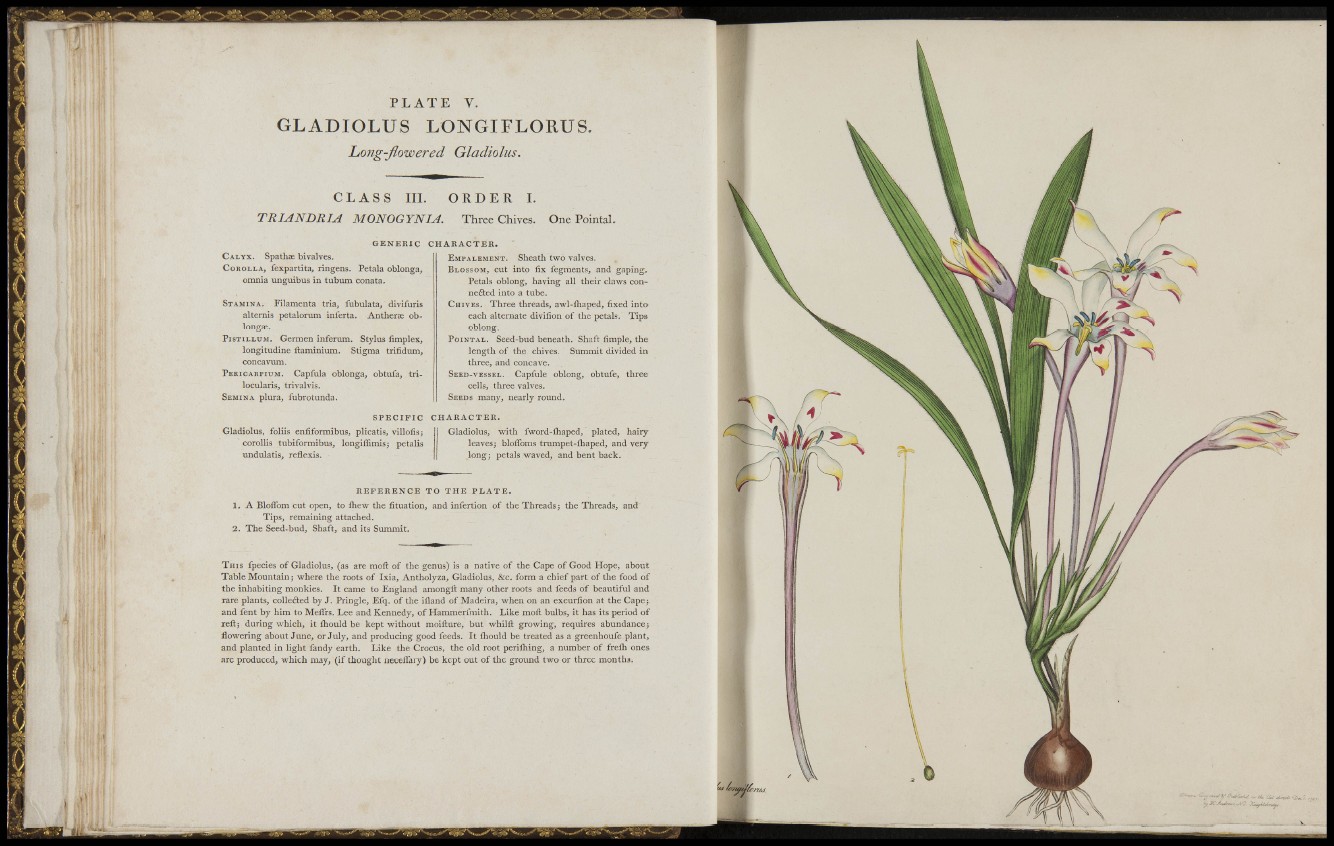
P L A T E V.
GLADIOLUS LONGIFLORUS.
hong-flowered Gladiolus.
C L A S S IIL ORDER L
TRIANDRIA MONOGYNIA. Three Chives. One Pointal.
G E N E R I C CHARACTER.
C A L Y X . Spathse bivalves.
C O R O L L A , fexpartita, ringens. Pétala oblonga,
omnia unguibus in tubum conata.
S T A M I N A , Filamenta tria, fubulata, divifuris
alternis petalorum inferta. Antherae oblongas.
PisTiLLUM. Germen inferum. Stylus fimplex,
longitudine flaminium. Stigma trifidum,
conca vum.
P E R I C A R P I U M . Capfula oblonga, obtufa, trilocularis,
trivalvis.
S E M I N A plura, fubrotunda.
S P E C I F I C
Gladiolus, foliis enfiformibus, plicatis, villofis;
corollis tubiformibus, longillimis,- petalis
undulatis, reflexis.
E M P A L E M E N T . Sheath two valves.
BLOSSOM, cut into fix fegments, and gaping.
Petals oblong, having all their claws connefted
into a tube.
C H I V E S . Three threads, awl-fhaped, fixed into
each alternate divifion of the petals. Tips
oblong.
P O I N T A L . Seed-bud beneath. Shaft fimple, the
length of the chives. Summit divided in
three, and concave.
SEED-VESSEL. Capfule oblong, obtufe, three
cells, three valves.
SEEDS many, nearly round.
C H A R A C T E R .
Gladiolus, with fword-ihaped, plated, hairy
leaves; bloffoms trumpet-lhaped, and very
long; petals waved, and bent back.
E E F E R E N C E TO THE PLATE.
1. A Bloflbm cut open, to ihew the fituation, and infertion of the Threads; the Threads, and
Tips, remaining attached.
2. The Seed-bud, Shaft, and its Summit.
T H I S fpecies of Gladiolus, (as are moft of the genus) is a native of the Cape of Good Hope, about
Table Mountain; where the roots of Ixia, Antholyza, Gladiolus, &c. form a chief part of the food of
the inhabiting monkies. It came to England amongll many other roots and feeds of beautiful and
rare plants, collefted by J. Pringle, Efq. of the ifland of Madeira, when on an excurfion at the Cape;
and fent by him to Meffrs. Lee and Kennedy, of Hammerfmith. Like moil bulbs, it has its period of
reft; during which, it ihould be kept without moifture, but whilft growing, requires abundance;
flowering about June, or July, and producing good feeds. It fhould be treated as a greenhoufe plant,
and planted in light fandy earth. Like the Crocus, the old root perifhing, a number of frefli ones
are produced, which may, (if thought neceflfary) be kept out of the ground two or three months.